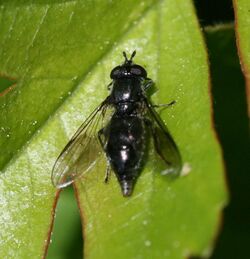Biology:Pipiza austriaca
| Pipiza austriaca | |
|---|---|

| |
| Pipiza austriaca female | |
| Scientific classification | |
| Domain: | Eukaryota |
| Kingdom: | Animalia |
| Phylum: | Arthropoda |
| Class: | Insecta |
| Order: | Diptera |
| Family: | Syrphidae |
| Subfamily: | Pipizinae |
| Tribe: | Pipizini |
| Genus: | Pipiza |
| Species: | P. austriaca
|
| Binomial name | |
| Pipiza austriaca Meigen, 1822[1]
| |
Pipiza austriaca is a species of hoverfly, from the family Syrphidae, in the order Diptera.[2]
Description
External images
For terms see Morphology of Diptera
Wing length 6–8 mm. Hind femora strongly thickened, with a large ventral ridge. Wing with darkened cloud. Thorax and abdomen pale-haired. The larva is described and figured by Goeldlin (1974) [3] See references for determination.[4][5][6][7][8]
[9]
Distribution
Palearctic Atlantic Europe. All Europe if older determinations are correct.[10][11]
Biology
Habitat:Quercus woodland clearings thickets of Rubus fruticosus along hedges, field-margins with a tall herb layer Atlantic scrub (Corylus) along hedges, field-margins with tall herb vegetation.[12] Flowers visited include umbellifers, Euphorbia, Ranunculus. [13] Flies mid-June to end August. Pipiza larvae are predators of gall forming aphids.
References
- ↑ Meigen, Johann Wilhelm (1822). Systematische Beschreibung der bekannten europäische n zweiflugeligen Insekten. Hamm: Dritter Theil. Schulz-Wundermann. pp. x, 416, pls. 22–32. https://www.biodiversitylibrary.org/item/49298#page/7/mode/1up. Retrieved 14 April 2019.
- ↑ Chandler, Peter J. (1998). Checklists of Insects of the British Isles (New Series) Part 1: Diptera. Handbooks for the Identification of British Insects. 12. London: Royal Entomological Society of London. pp. 1–234. ISBN 0-901546-82-8.
- ↑ Goeldlin de Tiefenau, P. (1974) Contribution a l'etude systematique et ecologique des Syrphidae (Dipt.) de la Suisse occidentale. Bull.Soc.ent.Suisse, 47: 151 - 252.
- ↑ Stubbs, Alan E.; Falk, Steven J. (1983). British Hoverflies: An Illustrated Identification Guide. British Entomological & Natural History Society. pp. 253, xvpp.
- ↑ Van Veen, M. (2004) Hoverflies of Northwest Europe: identification keys to the Syrphidae. 256pp. KNNV Publishing, Utrecht.addendum
- ↑ Van der Goot,V.S. (1981) De zweefvliegen van Noordwest - Europa en Europees Rusland, in het bijzonder van de Benelux. KNNV, Uitgave no.32: 275pp. Amsterdam.
- ↑ Bei-Bienko, G.Y. & Steyskal, G.C. (1988) Keys to the Insects of the European Part of the USSR, Volume V: Diptera and Siphonaptera, Part I. Amerind Publishing Co., New Delhi. ISBN:81-205-0080-6.
- ↑ Coe, R.L. (1953) Diptera: Syrphidae. Handbks.ident.Br.insects, 10(1): 1-98. R.ent.Soc.London. pdf
- ↑ Bartsch, H., Binkiewicz, E., Klintbjer, A., Rådén, A. & Nasibov, E. (2009) Blomflugor: Eristalinae & Microdontinae. Nationalnyckeln till Sveriges flora och flora, DH 53b. Artdatabanken, SLU, Uppsala. 478pp.
- ↑ Fauna Europaea
- ↑ Peck, L.V. (1988) Syrphidae. In: Soos, A. & Papp, L. (eds.) Catalogue of Palaearctic Diptera, 8: 11-230. Akad.Kiado, Budapest.
- ↑ Speight, M.C.D. (2011). "Species accounts of European Syrphidae (Diptera)". Syrph the Net, the Database of European Syrphidae 65: 285pp. http://www.diptera.info/downloads/StN_Species_Accounts_Glasgow_2011.pdf.
- ↑ de Buck, N. (1990) Bloembezoek en bestuivingsecologie van Zweefvliegen (Diptera, Syrphidae) in het bijzonder voor België. Doc.Trav. IRSNB, no.60, 1-167.
Wikidata ☰ Q2746979 entry category:Taxa named by Johann Wilhelm Meigen
 |


